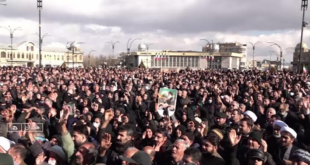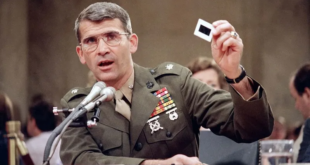
America’s senior arms negotiator said Washington is taking diplomatic and military steps to put an end to Beijing’s “great wall of secrecy” that surrounds its rapid and expanding strategic weapons program.
Speaking at a Heritage Foundation online forum this week, Marshall Billingslea, senior envoy for arms control, said Xi Jin-ping and the Communist Party leadership are engaged “in a crash nuclear build-up” with the intent of re-establishing China as the Middle Kingdom, the dominant global power.
China continues “to hide a dagger in a smile” diplomatically, Billingslea said.
Billingslea contrasted the more than 100-page document the United States has released on nuclear strategy to the five paragraphs China has publicly released on its nuclear program and strategy. He said in prepared remarks and in answers to questions that the United States is willing to engage in nuclear arms talks with Beijing and Moscow to avoid a new nuclear arms race.
Billingslea was speaking a little more than a month after the Pentagon released a report saying China has 200 operational nuclear weapons in its stockpile and is driving to at least double that number over the next decade.
Visible proof of Chinese intentions to build up strategic forces came most recently in the two-and-a half-mile-long parade of cruise and ballistic missiles on Oct. 1. In marking the 70th anniversary of the Communist takeover of China, Xi unveiled a new mobile launched DF-41 intercontinental missile.
For the past several years, Beijing has “aggressively” been testing cruise and ballistic missiles. Billingslea said that as of August, China has conducted “at least 70 this year.” The schedule “portends a major shift in Chinese nuclear posture.” Several times during the forum, Billingslea noted that the shift was taking place as Beijing increased pressure on Taiwan, asserting its territorial claims in the South and East China Seas and escalating border tensions with India.
“This is a warmongering Communist Party,” he said.
Billingslea said, “this cannot continue.” The result of China’s secrecy over the nuclear program, the aggressive cruise and ballistic missile testing and its refusal to join in serious arms control talks could lead to a three-way nuclear arms race.
The great danger is that Chinese nuclear “capability is likely outpacing their strategic thinking.” He noted China is also operating as a major nuclear power without any hotline connections to Washington or protocols on data exchanges to avoid miscalculations in a crisis.
“Diplomacy has not yet run its course,” he said. Billingslea argued countries would see Beijing in a better light internationally if China sat down to talk with the United States and Russia, as its prestige has fallen for its aggressive behavior and its initial handling of the COVID-19 pandemic.
Billingslea noted the support from Washington’s European allies — Austria, Sweden and expected support from New Zealand and Australia — on pressing the Chinese to honor their commitment to the Nuclear Non-Proliferation Treaty and become involved in writing a new strategic arms agreement.
As a way to entice China to participate in serious negotiations, “we’ll start with the Russians” on extending the START [Strategic Arms Limitation Treaty], he added. But any “new treaty has to be multilateral,” meaning China needs to come aboard at some point.
“We’re ready to strike the deal” to extend the treaty’s terms with the Kremlin, freezing nuclear weapon stockpiles, but with new verification methods in place. China has to come aboard at some point to make the treaty viable.
Other nuclear powers, especially India, are watching to see whether China chooses to engage in these new strategic arms limitation talks, Billingslea said.
For allies and other nations, he said “now’s time to ring up the Russians and tell them to take the deal.” The next step would be for Moscow to work to bring China into the wider negotiations. So far, they “are not going to us get there.”
Right now, the Chinese “want to finish the build-up before they sit down to talk,” he added.
The steps the United States is taking to counter Chinese and Russian nuclear build-ups include modernizing its nuclear triad — from systems like the Columbia class ballistic missile submarine to low-yield warheads and sea-launched missiles. Billingslea added that Washington is also developing land-based intermediate-range ballistic and cruise missiles for the Army and Marine Corps and hypersonic weapons.
Billingslea estimated China has “as many as 2,000 intermediate-range ballistic and cruise missiles.” Like START, China was never part of a treaty agreement to limit these weapons. The United States withdrew from Intermediate-Range Nuclear Forces Treaty in 2019, arguing Russia had violated its terms repeatedly by stationing missiles with a range of 500 TO 5,500 kilometers on its western border.
In addition, to show Beijing that China’s “wanton aggression to your neighbors has consequences,” Billingslea said the United States will field new missile defense systems throughout Asia and Europe.
 Eurasia Press & News
Eurasia Press & News



